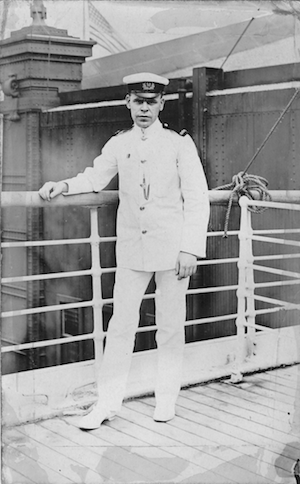1884 ~ Jack Binns is born in Brigg, Lincolnshire, September 16th. He is raised by his maternal grandmother and uncle in Peterborough, Northhamptonshire, where his uncle is a tailor of modest means.
The narrow Binns home in Peterborough. Photo courtesy Sidney Harbour.

1898 ~ Passes his school leaving examinations and goes to work at age 13 as a messenger for the Great Eastern Railway in Peterborough.
1898 ~ Binns' legs were nearly severed by a railway car. The doctors do not amputate because they believe he will not survive. But survive he does! He takes advantage of the year he spends in traction to read every book his doctors can bring him. Eventually he is able to walk on crutches and returns to work, this time as a junior operator. The wounds finally heal two years after the accident!
1901 ~ Offered the position of senior operator, second in charge, of the important Colchester Telegraph office, the main switching line between England, continental Europe, and Asia, and the headquarters of the Eastern Command of the British Army. Teaches himself how to repair broken lines, apparatus, and connections, and devises ways to get around sunspot interference.
1903 ~ (age 19) Passes tests and is accepted as an expert operator in the British Post Office Telegraph Service at Newmarket, the racing town.

1904 ~ Starting in December, Binns attends the Marconi training school in Seaforth, and is certified as a wireless operator after three months' training-the standard was 6 to 10 months!
1905 ~ He receives his first assignment, on the Kaiser Wilhelm der Grosse of the Hamburg Amerika Line. He sails on German ships until 1908.
1908 ~ All foreign wireless operators are barred from working on German ships by order of the Reichstag, so Binns is sent, first to test new equipment for the Ostende-Dover ships, then to the Marconi Station at Crookhaven in Ireland for six months.
1909 ~ Assigned to the RMS Republic.
1909 ~ January 23rd, collision of the Florida with the Republic. Binns hailed as hero.
Jack Binns on the Adriatic in the summer Marconi uniform, 1910.

1910 ~ Assigned to Adriatic, where his captain is E.J. Smith, later captain of the Titanic.
1911 ~ At the request of Captain Smith, he is due to be assigned to the Olympic and then the Titanic, but J. Bruce Ismay, head of the White Star Line, is worried that he might bring bad luck and bad publicity to these new ships. Therefore he is assigned first to the Caronia and then to the Minnewaska, and also receives the post of traveling inspector, created for him.
1912 ~ Resigns from the Marconi company to work for William Randolph Hearst at the New York American. Two days after he begins his new career, the Titanic strikes an iceberg and sinks. He reports extensively on the disaster for the New York American. He testifies at the Titanic inquiry.
1917 ~ Joins the Royal Flying Corps of Canada and the is transferred to the Royal Air Force of Great Britain as a flight and wireless instructor.
1918 ~ Returns to newspaper work, and is radio and aviation editor of the New York Tribune, editing the weekly radio supplement. Also contrubutes articles to Popular Science Monthly, and writes the prefaces to the Radio Boys Series.
1924 ~ Joins Hazeltine Corporation as assistant treasurer. Hazeltine was formed to handle the patents developed by radio pioneer Louis Alan Hazeltine, and to develop and license new electronics patents for other inventors and corporations. Hazeltine developed the neutrodyne circuit that made radio commercially viable by decreasing interference and the high-pitched squeals of static.
1926 ~ Becomes treasurer of Hazeltine.
1927 ~ Becomes member of the Board of Directors of Hazeltine.
1935 ~ Becomes vice-president of Hazeltine.
1942 ~ Elected President of Hazeltine.
1952 ~ Elected Chairman of the Board of Hazeltine.
1955 ~ Resigned from the Presidency of Hazeltine.
1957 ~ Elected Honorary Chairman of the Board of Hazeltine.
1959 ~ Dies of a stroke December 8th, 1959, in New York City.
MEMBERSHIPS AND WRITINGS
Binns was a member of a number of professional organizations, including the Radio Club of America, the Society of Naval Engineers, the Armed Forces Communications and Electronics Association, and the Society of Silurians.
During his time as a newspaper reporter and thereafter he also wrote the forewords to the twelve books of the Radio Boys series published by Grosset and Dunlap under the pseudonym Allen Chapman between 1922 and 1930.
Binns tried his hand at novel-writing himself, with The Flying Buccaneer: A Novel of Adventure in the Skies published by Nicholas L. Brown in 1923. This book was written to promote the advantages of heavier-than-air planes at a time when Zeppelins were becoming hugely popular.


